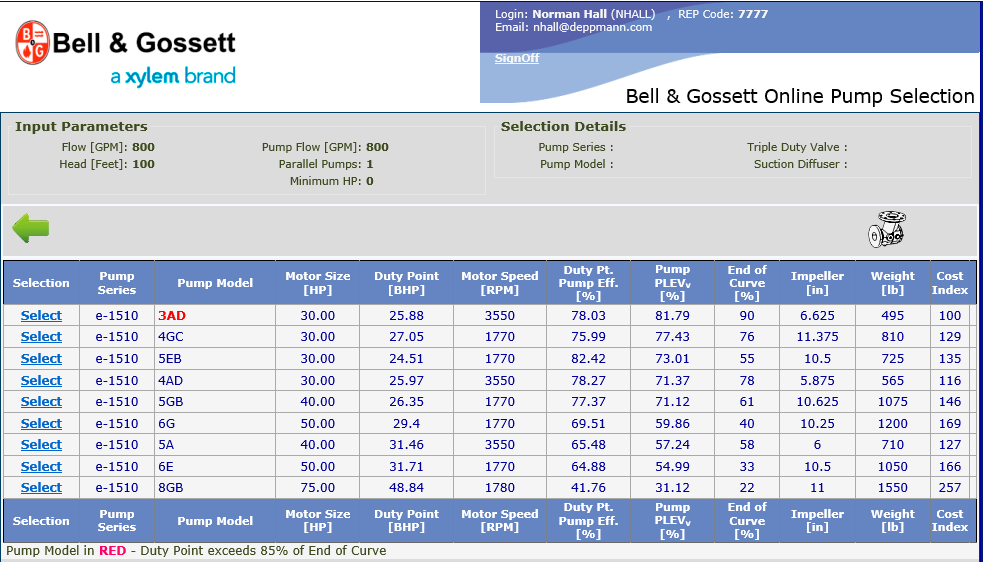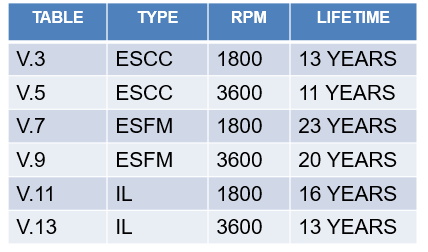In the last two Monday Morning Minutes, we introduced the PLEV, or Part Load Efficiency Value, from Bell and Gossett. When we use part load efficiency as the only criteria for selection, we may end up with HVAC pump selections that we wouldn’t normally choose. This week we examine those selections.
Bell and Gossett developed PLEV to create a weighted average of the pump efficiency for the HVAC and plumbing industry. This new efficiency average gives the engineer or designer an efficiency that may more closely represent the actual efficiency of a variable volume system.
In part 2 of this series, we offered the following selection table sorted on PLEV:
The most efficient part load selection is the e-1510-3AD with a PLEV (part load efficiency value) of 81.79. This selection is 3500 RPM and not the traditional 1750 normally scheduled.
3500 vs. 1750 Pump Selections: The Good
Although 3500 RPM is not normally used in HVAC applications, there are some good reasons to consider it. The first reason is cost. This 3500 RPM selection has a PLEV which is four points higher than the next selection. If the application load profile is close to the PLEV load profile , the 3AD selection will save hundreds of dollars per year in operating cost.
In addition, the column to the far right on the selection table has a cost index. This index shows the next 1750 RPM pump will be 29% more in initial cost than the 3500 RPM selection. In this case, subject to specification requirements, the difference could be $500 to $1,000 in first cost. You can give us a call for budget pricing for pumps.
One other good reason is the mechanical space. The 3500 RPM selection is a bit smaller and will take up less mechanical room space.
With all of these advantages, this could be a serious consideration.
3500 vs. 1750 Pump Selections: The Bad
So why don’t we always use 3500 RPM? The first reason is that most HVAC pump capacities have a more “balanced” flow and head, and 1705 is more efficient. Our example of 800 GPM with 100 feet of head is an unusual selection. It has a high head for an HVAC application. In many selections, the 3500 RPM pump is too far to the left of BEP, or best efficiency point, to have a high PLEV.
Another reason most engineers bypass 3500 RPM selections is noise. 3500 RPM motors are audibly louder than 1750 RPM. Even when the speed is reduced, there is a higher pitched “tinny” sound from the motor. A joke around the office is that we don’t have to go into the mechanical room to see if a pump is 3500 RPM, we can hear it in the hallway. So noise is one major factor.
A third factor is wear and tear—although this is more of an opinion. If you run a car at 6000 RPM it will require more maintenance and repair than if you run it at 3000 RPM. We believe pumps are the same. The seal and bearings in a pump selected for design at 3500 RPM will be at 1750 RPM at half speed, while the pump selected at 1750 RPM would run at 875 RPM at half speed. There is more heat in the higher RPM selection and that heat will cause an earlier demise to pump parts. We experience this in the frequency of calls for parts. Your client will have more cost of repair with a 3500 RPM selection than 1750. In fact the recent U.S. Department of Energy (DoE): Energy Conservation Standards for Pumps indicate “pumps running faster tend to have a shorter lifetime.”
A fourth concern involves NPSH, or net positive suction head, which may be a concern in few closed systems but many open systems. 3500 RPM selections tend to have higher NPSH requirements than 1710 RPM selections.
3500 vs. 1750 Pump Selections: The Ugly
There is one last major concern with 3500 RPM selections. Many chiller manufacturers use 3500 RPM in their chillers. The operation and maintenance manuals of these chillers suggest the engineer not use 3500 RPM pumps in the same area as the chillers due to a concern about damage caused by harmonics.
This isn’t always an issue, but the engineer should at least be aware of it when choosing the pump speed.
The recent U.S. Department of Energy Pump standards looked at energy use and examined average pump lifetimes. The results clearly show the end suction 1800 RPM pumps have the longest life for your clients. Here is a synopsis of the data in their tables:
Final Comments About 3500 RPM Selections
Bell and Gossett markets and sells pumps at various speeds and the engineers at B&G are confident that any 3500 RPM pumps are quality products designed to operate at the published speed or lower.
The decision about 3500 RPM vs. 1750 RPM is all about the engineer weighing pros and cons as they often do in the entire design of the HVAC system. The authors of this article believe that in most cases, the advantages of 1750 and the historical trouble-free operation of B&G 1750 RPM pumps in hydronic HVAC applications normally outweigh the advantages of 3500 and, therefore, we recommend continuing the 1750 RPM selections and schedules.
Next week we will look at another column in the selection chart: percent of end of curve.



